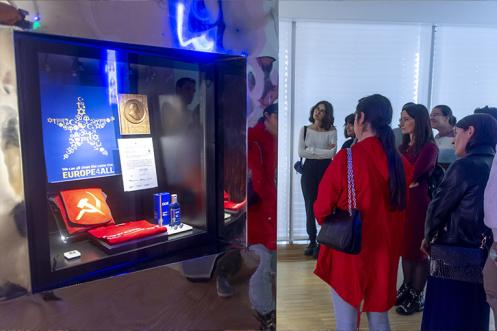
By Dora Valčić, Trainee in the Learning and Outreach department
The first European Innovation Days in History Education took place in Brussels in March 2023. The House of European History hosted the HISTOLAB project, which focuses on innovation in history education, and new initiatives in research, academia, and teaching practices.
Friday 10 March, was a very busy day at the House of European History. Alongside visitors from across Europe and the world, the museum was also full of teachers, academics, researchers, junior professionals, as well as students, all from the field of history. From the sound of the suitcase wheels in the lobby, all the participants knew, it was the final day of the Innovation Days program. The entrance hall and first floor were buzzing. One could hear the chatter among the crowd, old colleagues catching up, new ones networking, everyone slowly gathering before the start of the guided tours, parallel workshops and presentations.
The focus of the day’s sessions was the innovative use of sites of remembrance, historical places and museums. Therefore, the first workshop I attended took place in the galleries of the museum, since that was a perfect place for Laurence and Paul, the colleagues from the learning team, to present the digital toolbox for history learning. "Are there history professors? Do you teach the history of the European Union, and how?" — asked Paul, to break the ice after the group assembled on the fourth floor of the museum. The participants immediately raised their hands. History teachers and students, researchers, and other scholars from all over Europe, were quick to share their experiences and opinions.
Laurence then took the floor and shared a brief history of the museum, followed by the instructions for the day’s activity — the Visual Thinking exercise. We were given small post-it notes and were instructed to carefully look at one of the objects in the exhibition. After looking, we were asked to write three words, two sentences and one question that came to mind. Laurence collected all the post-its and revealed the context of the object. It was a pennant of the European Movement, which is a part of the story of the Congress of Europe. One of the outcomes of this Congress was the creation of the Council of Europe, a continent-wide organisation for collaboration on cultural and human rights. Now there were even more ideas and questions from the group, which ultimately led to the interconnection of ideas from the beginning and end of the exercise. Laurence shared all the answers to the questions and everyone involved in the activity continued towards the galleries, learning another part of history in a new way.
As the group continued to explore the exhibition on the fourth floor, Paul presented how Cognac, Jean Monnet and other personal stories make the history of the European Union more appealing to young people, and how living conditions changed in the 1950s and 60s across Europe. Finally, Laurence explained how the learning team is launching the development phase of the new digital toolbox. All the participants gained insights into the front-end evaluation led by the learning team, to ensure that this new digital toolbox will be relevant, engaging, and meet the needs and expectations of the teachers who will use it. Furthermore, all participants were informed on how they can take part too!

